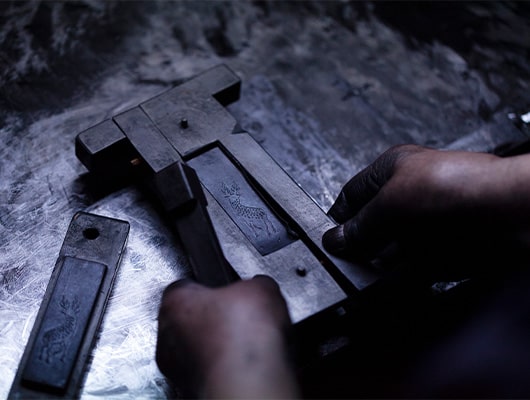- HOME
- What is Nara Sumi?
What is Nara Sumi?
Art of Eastern culture
Nara Sumi, or ink made in Nara, is made through a traditional method that goes back over a thousands years, that has been hardened into a stick so that it is easier to carry around. At its core, its ingredients are simply soot and gelatin, with spices added to give it a nice aroma. However, it is only through these months-long, traditional techniques that we can produce sticks of Nara Sumi that people have used to write with for more than a thousand years.
The form of the ink itself is just as beautiful as it is on paper. While it is still raw, we using wooden molds to give the ink subtle, detailed patterns deeply connected with Japanese culture and the history of Nara.
It is said that Nara Sumi can be used for up to 1,000 years. From shaping it in the first moment when it is raw to writing with it 1,000 years later, the power of expression within Nara Sumi is limitless. Whether for writing or decoration, we hope you feel the raw, true beauty of Nara Sumi.
The Subtle Beauty of a Traditional Ink Stick
Moment to calm the mind
Until recent years, the practice of writing in Japan began by rubbing a hard ink stick in a small amount of water. Rubbing small, soft circles over and over just to create a small amount of ink was considered part of the writing process, a moment to calm the mind before one dips their brush into the ink. As the hand writes what the mind dictates, the characters on the paper are an expression of that unification of mind and body, both in meaning and style. The mixture of soot and gelatin in traditional ink sticks determines its shade of color, the feel of the initial strokes, and how much the ink blots or cracks on the paper, all features which one can skillfully use to express the most in their writing. Though many different kinds of Nara Sumi may appear to be black, they contain different ingredients, and when compared next to one another, they start to resemble shades of red or blue.
Bottled liquid ink has become more convenient and common in recent years. However, the true price of this convenience are the nuanced lines, shades, blots, and cracks in a stroke that bring a new depth of expression. Or it is the subtle shades of black on paper that whisper of the ink’s origins. Or it is the calm mind and body that comes from calmly taking the time to rub the ink stick before picking up that brush.













